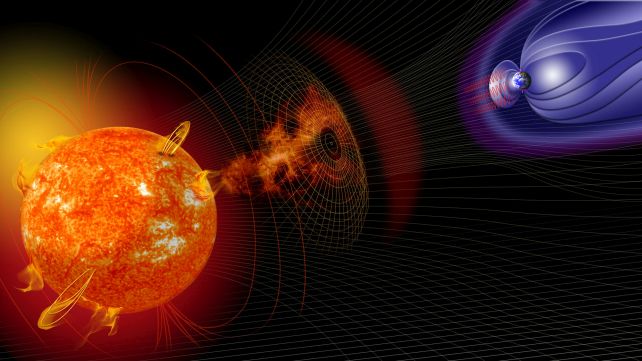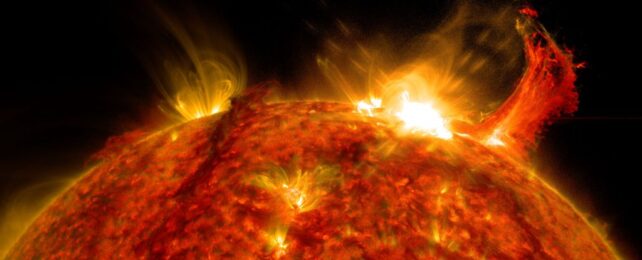A huge cosmic event some 14,300 years ago was so powerful, it left a discernible mark on our planet.
In the partially fossilized trunks of ancient trees, and excavated cores of millennia-old ice, scientists have found evidence that suggests some sort of massive space event took place in around 12350 BCE.
New work using a specially developed climate-chemistry model called SOCOL:14C-Ex clinches it. The culprit behind the huge particle influx during that time was a giant event from the Sun, pelting Earth with particles in the biggest geomagnetic storm we have on record.
"Compared to the largest event of the modern satellite era – the 2005 particle storm – the ancient 12350 BCE event was over 500 times more intense, according to our estimates," says space physicist Kseniia Golubenko of the University of Oulu in Finland.

A geomagnetic storm is an event usually associated with a coronal mass ejection, a huge expulsion of billions of tons of plasma, enmeshed with a magnetic field, from the Sun. When this particle influx slams into Earth, all sorts of wacky shenanigans can ensue.
The aurora australis and borealis are the most well-known manifestations of a geomagnetic storm, but such disturbances can get dangerous when mixed with our technology. The most famous example is the Carrington Event of September 1859, in which currents in the atmosphere then ran along Earth's surface, wiping out telegraph systems around the world, triggering fires and mayhem. Another big geomagnetic storm in 1989 saw multiple power grid failures and disruptions.

We know that the Sun is capable of much bigger outbursts, though. But because human records of solar storms are patchy at best, it's difficult to gauge just how strong a geomagnetic storm can get.
However, one quirk of geomagnetic storms is that they temporarily increase the amount of the radioactive carbon-14 that's constantly raining down on Earth. This radiocarbon is produced in the upper atmosphere when cosmic particles, like the particles belched out by the Sun, interact with atmospheric particles.
Carbon-14 is incorporated into organisms, such as trees and animals, and because it decays at a known rate, scientists can use it to determine when these organisms lived. Here's where it gets interesting: a huge spike in carbon-14 in a tree ring can be used not just to detect, but narrow down the date of a geomagnetic storm.
This is what researchers did to identify a potential giant geomagnetic storm 14,000 years ago, as explained in a 2023 paper. Other such events have been traced to around 994 CE, 660 BCE, 5259 BCE, and 7176 BCE, with the most recent (and previously largest known) being 774 CE.

The 12350 BCE event, however, is different from the others, which is why the team needed to design a model to understand it better.
"The ancient event in 12350 BCE is the only known extreme solar particle event outside of the Holocene epoch, the past ~12,000 years of stable warm climate," Golubenko says. "Our new model lifts the existing limitation to the Holocene and extends our ability to analyze radiocarbon data even for glacial climate conditions."
The researchers tested their model on the 774 CE event, and then, once it returned accurate results, used it to analyze the data from 12,350 BCE. This allowed them to probe the strength, timing, and terrestrial impact of the storm, confirming that it was the biggest solar particle storm that we know about.
"This event establishes a new worst-case scenario," Golubenko says. "Understanding its scale is critical for evaluating the risks posed by future solar storms to modern infrastructure like satellites, power grids, and communication systems."
The research has been published in Earth and Planetary Science Letters.
